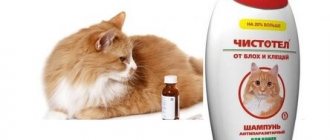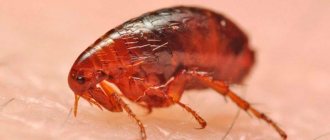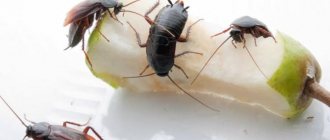Fleas on a cat are a very common problem that every owner can face, even if the pet never leaves the apartment. Flea control and disinfection of cat beds should be carried out immediately as soon as the first signs of the appearance of these blood-sucking insects are noticed.
How to tell if your cat has fleas
When fleas appear on a cat, it is not difficult to recognize them, because the emerging insects cause anxiety and discomfort to the animal.
How to find out and check if a cat has fleas:
- The pet's behavior changes - it often itches, bites the fur and licks it. A cat can perform such actions at any inopportune moment - while eating, while playing, during sleep;
- if a cat has fleas, then any part of the body will itch and itch, regardless of the thickness of the coat;
- in areas of more frequent scratching on the cat’s body, bald patches and skin damage may form;
- You can determine the presence of fleas by their waste products - small dark grains remain on the skin next to the wounds;
- Having an idea of what a flea looks like on a cat, it is easy to see it by carefully examining the fur or combing it out;
- If a cat has fleas, then eggs can be seen on the fur or bedding - they are oval in shape, very small, and white.
Lemons
One of the most effective natural flea remedies is citric acid, which makes lemon juice a widely accepted home remedy for fleas.
You can spray your cat's fur with a solution made by boiling a sliced lemon or two (let the lemons sit for a few hours), then drain the liquid before pouring it into a spray bottle.
Gently apply the solution to your car's fur—just avoid his or her eyes and monitor your pet for redness or other signs of irritation—and repeat the treatment as needed until the fleas are completely gone.
If your cat hates water—as most cats do—you can also try using a comb soaked in the solution to brush out the fleas.
If you are concerned about lingering fleas and flea eggs, add a cup of lemon juice to the laundry when washing your pet's bedding to help get rid of any remaining bugs.
How does infection occur?
Fleas are small brown insects with a body flattened on the sides. This shape allows them to easily slip through the cat's fur and reach the skin. These insects are very mobile. They do not have wings, but thanks to their long hind legs, adults are able to jump long distances. The most common cause of infection is jumping from a sick cat to a healthy one. This is how animals living in nurseries or shelters, or who have the opportunity to walk on the street, become infected.
Fleas can also appear in a pet that lives in a limited area and does not walk or communicate with its relatives. To understand where fleas come from in a domestic cat, you need to know that these blood-sucking insects are prone to rapid reproduction, which has some characteristics.
How fleas reproduce in cats:
- the female lays eggs on the animal’s fur, which have an elongated oval shape and are painted white;
- the eggs do not attach to the fur and after a while fall off to the floor, bedding, or ground. The eggs can be anywhere where the infected cat was;
- The eggs hatch into larvae, which after some time form a pupa, where a flea is formed. She can stay in the cocoon for a very long time and will come out only when she senses that a cat is nearby;
- How quickly fleas reproduce depends on air temperature and humidity.
Flea eggs can be brought home on shoes or clothing. In favorable apartment conditions, they will quickly go through all stages of development from the appearance of the larva to the maturation of an adult flea and its attack on the pet.
Oregano oil
Oregano oil contains a chemical called carvacrol. It is a natural antiseptic that kills both fleas and germs. Mix one teaspoon of oil with three teaspoons of olive oil and apply the resulting liquid to your cat's ears, skin and fur with a cotton ball.
Treating your cat with home remedies can be a simple but powerful way to rid your cat and your home of fleas. Using these medications will provide gentle and safe means of relief without the use of harsh, irritating chemicals.
Useful links:
Why are fleas dangerous?
It is important to start treating fleas in domestic cats as early as possible - as soon as the first symptoms appear. In addition to the fact that blood-sucking insects bite painfully, they cause harm to the entire body:
- large bald patches form on the body;
- Dermatitis and eczema occur at the site of scratching;
- some cat worms are transmitted through fleas;
- fleas are carriers of infectious diseases;
- If measures against fleas in cats have not been taken for a long time, then the pet may have nervous disorders.
Fleas are very dangerous for a kitten. If there is a large accumulation of insects on a small body, the result of their harmful activities can be anemia, which cannot always be cured.
TEAR OR PUS IN A BABY'S EYE: SOUND THE ALARM!
25.11.2019
The appearance of purulent discharge in a baby’s eyes is always unpleasant and indicates health problems. However, is it worth taking your child to the doctor or is it just a minor nuisance like a cold that will “go away on its own”? Igor Aznauryan, ophthalmic surgeon, Doctor of Medical Sciences, professor, founder of the Yasny Vzor children's eye clinics, will tell you what modern ophthalmology offers to solve this problem.
Eye suppuration in infants: causes and symptoms
Obstruction of the nasolacrimal duct first appears in a newborn. In our body, the lacrimal drainage system is arranged as follows: the lacrimal canaliculi pass into the lacrimal sac, then into the nasolacrimal duct, which opens into the nasal cavity. That is, normally tears enter the nose through the system of these tubes. During intrauterine development, this passage is closed by a membrane, which should dissolve at approximately 8-9 months of pregnancy. However, sometimes it does not resolve, the passage in the newborn remains closed, and, as a result, the tear, instead of washing the eye and going into the nose, remains in the eye cavity and flows out.
Dirt and dust get into this tear, and with them microbes that begin to actively multiply. Everything that should be washed off and gone into the nose remains in the eye. This leads to inflammation, that is, conjunctivitis, most often bacterial. This is how suppuration of the eyes appears. With normal patency of the duct, after instillation of antibacterial or antiseptic drops, the inflammation goes away. However, in case of obstruction, as soon as the mother stops dripping drops, the eyes begin to fester again. Obstruction of the nasolacrimal duct due to the presence of unresolved membrane and the resulting suppuration of the eyes is called dacryocystitis of newborns.
Sometimes the disease occurs immediately after birth, sometimes after a few months, when tear production begins to become more active. But most often, a child’s eyes begin to fester about two weeks after birth.
What should parents do?
It is best to immediately contact a pediatric ophthalmologist. He will prescribe drops and show the massage technique, because sometimes there is no patency not due to the presence of a membrane, but simply because the lacrimal ducts are clogged with a mucus plug that appeared there during the period of intrauterine development. In this case, massage is indicated. It will help push out the mucus plug so that the tear ducts are cleared, become passable, and tears can escape into the nose.
However, in the case of a membrane, massage will not remove it; it can only alleviate the child’s condition in the first two weeks. But if after a course of massage it has not changed, then you are dealing with obstruction due to the fault of the membrane. In this case, the useless massage should be stopped and the eye should be kept clean with drops before probing.
Sensing: what is it and why is it necessary?
It is performed in 3-4 months, because... Before this, the mucous membrane is very tender and easily injured. By this age, it becomes completely clear that we are dealing with true obstruction of the nasolacrimal duct, and the disease will not go away on its own.
Sounding is carried out under medicated sleep conditions, when the child breathes through a mask. It is safe, painless and fairly quick (the procedure lasts about 10 minutes). First, the doctor confirms the obstruction during a consultation, then the child is taken to the hospital after he has been examined by an ENT specialist, a pediatrician, and a cardiologist. The ENT specialist is a key figure because he must determine whether there are any barriers to tears from the nose. If they are not there, then the child in the hospital is put to sleep, probing is performed, and after two hours the baby can go home.
The essence of probing is that the doctor uses a metal probe to pass through the tear outflow path. That is, the lacrimal canaliculi, lacrimal sac, lacrimal duct, and completes the procedure in the nose. A small child has a very thin mucous membrane; these channels have a complex structure: many bends and valves, expansions and contractions. That is why it is fundamentally important to do this in medicated sleep, when the child does not feel anything, does not scream or disturb the doctor. In modern medicine, treating children by force, by holding them down, is simply unacceptable - this is a huge stress, and besides, the doctor cannot carry out the procedure quickly and efficiently while the child is desperately struggling. Medication-induced sleep helps to avoid complications, rupture of canal walls, fracture of bone walls, formation of false passages and fistulas.
After the procedure, its effectiveness is checked using contrast. The dye is supplied through the lacrimal openings, which should enter the nose. Dye in the nose shows that patency has been restored.
Sometimes it happens that the lacrimal canal is not formed at all; in principle, it does not exist anatomically. In this case, the doctor will not be able to help with probing, but after this procedure he will tell the parents what to do. Most often, stenting or dacryocystorhinostomy surgery to form canals is indicated. It can be performed from 4-6 months, endscopically, i.e. without scars or scars.
Repeated probing and complications
Sometimes, when probing is carried out without medicated sleep, the baby goes through the procedure 3-4 times, but there is still no point. This means that complications have already developed. For example, the probe did not go into the nose, but into the soft tissue of the cheek. The result is false passages, pockets where pus and bacteria accumulate, and the formation of fistulas is possible.
In fact, the risks of unsuccessful probing or delaying this procedure are very high - a constant purulent process occurs next to the eye on the child’s face. The infection can spread to adjacent tissues and through the bloodstream throughout the body.
There is another reason why the procedure for restoring patency should not be postponed. With dacryocystitis of newborns, the purulent process occurs in the lacrimal sac. The lacrimal sac overstretches and loses its elasticity. If the probing procedure is delayed for a long time, then the lacrimal ducts will not perform their “pumping function.” That is, even when patency is restored, the tear will not go well into the nose. This will manifest itself as lacrimation. A child, even as an adult, will suffer from constant tears.
And finally, the older the child, the higher the risk of complications, because the mucous membranes of the canals are already damaged by constant inflammation and are very easily injured. That is why probing must be performed on time and under medicated sleep conditions.
My area, November 25, 2019
Methods for removing fleas
There are many recommendations on how to remove fleas from a cat, and all of them are quite effective. Which flea remedy to use in each specific case depends on several factors:
- pet's age;
- whether the cat is pregnant or not, whether she is feeding kittens;
- degree of damage to the skin and coat;
- presence of concomitant diseases;
- How long has the cat been infected?
If your pet does not have any concomitant diseases, then you can treat your cat for fleas yourself. You should contact a veterinarian when it is not clear how to remove fleas from a cat, or what product to use if she has severe hair loss, develops dermatitis, or has a deterioration in her health.
What flea remedies are there for cats?
- sprays and aerosols;
- shampoos;
- drops;
- collars;
- powders;
- pills;
- injections;
- folk remedies.
How to remove fleas from a cat at home and prevent re-infection depends on the specific use of the chosen product.
Sprays and aerosols
The spray is a fairly effective remedy for fleas in cats. The wool should be treated generously, dividing it into partings so that the product gets on the skin. It acts quickly and can be used to remove fleas from kittens and pregnant cats. When treating with a spray or aerosol, pay attention to the following:
- the sprays we use to remove blood-sucking insects from dogs cannot be used to treat cats because they contain some substances harmful to cats;
- flea preparations for cats in the form of an aerosol or spray must be used carefully so that the active substance does not get into the pet’s mouth or respiratory tract;
- treating lactating cats against fleas using a spray is not recommended, because kittens may be poisoned during feeding;
- flea repellent for treating cats' fur and removing them from the litter - these are different preparations and they must be used strictly for their intended purpose;
- Before using the spray, you must read the instructions and follow the rules. In some cases, after treatment, it is necessary to wash the drug from the fur, which requires bathing the pet.
Shampoos
A good and gentle flea remedy for cats is shampoo. It is most effective for kittens and for pets who do not leave the apartment. This remedy does not have a long-term effect, therefore, in order to avoid re-infection, it is necessary to treat all areas where the pet is.
How to remove fleas from a cat at home using shampoo:
- before bathing, the pet must be thoroughly combed;
- moisten the wool generously with warm water and apply a small amount of shampoo;
- when soaping, you should not skip such areas as the tail, tips of the paws, and belly;
- After soaping, the foam does not need to be washed off immediately, it should act for 2-3 minutes;
- rinse with plenty of water;
- Wipe the cat dry and, if necessary, dry the fur with a hairdryer.
Important: when bathing your cat, you need to make sure that shampoo and water do not get into the ears.
Shampoo is the best flea treatment for cats as a preventive measure. If your pet easily tolerates water procedures, then you can use anti-flea shampoo for washing each time. You should know that different types of shampoos are produced for long-haired and short-haired breeds.
Drops
The most effective remedy for both fleas and ticks for cats is drops. This is one of the effective remedies against lice eaters, mosquitoes and other blood-sucking insects. They are applied to the withers and upper back along the spine. The drops have a prolonged effect and are recommended for use on pets who constantly walk in the yard.
How to get rid of fleas on a cat using drops:
- carefully study the instructions and calculate the dosage of the drug based on the weight of the animal;
- It is not recommended to carry out water procedures three days before using the drops and three days after;
- drops are applied along the spine to the lower part of the head, neck and upper back (these are the places that the cat cannot reach and lick the drug);
- drops should be applied directly to the skin, moving the fur away;
- During the summer season, drops are used repeatedly, at the intervals specified in the annotation for the medicine.
Collars
Collars have a long-lasting effect, but not all cats get used to them. While for some pets a collar can become an inconspicuous accessory from the first day, others have to be trained for a long time and distracted at the moment when they try to take off the collar. This product is not very suitable for cats with very long and thick hair, because after prolonged wear, tangles form on the neck. For such cats, it is better to alternate the collar with other means or wear it only for walks.
Powders
Powders are very rarely used as a cure for fleas for cats, but they are convenient at the moment when we get rid of fleas and their larvae in cats’ habitats. The powder can be sprinkled on the floor in the apartment, furniture, carpets and bedding for animals. After some time, the powder is collected with a vacuum cleaner, brush or swept out with a broom and wet cleaning is carried out. It is advisable to use very warm, almost hot water to disinfect the room. Work is carried out with gloves.
Tablets and injections
Consult your veterinarian about flea tablets and injections. They are very effective and are used in cases where the cat is heavily infected, there are large areas of damage to the fur and skin, or the rapid destruction of blood-sucking insects is required due to the pet’s health condition.
These drugs have many contraindications; it is necessary to observe the exact dosage and anticipate possible complications. Tablets and injections for flea control are not recommended for pregnant and lactating cats, small kittens.
Folk remedies for fleas
It is possible to rid a cat of fleas using folk remedies if the damage is minor. The advantage of these products is the lack of toxic effects on the body, the ability to prepare them yourself and their effectiveness as a preventive measure.
A decoction of herbs is used to treat wool and spray cat litter. A folk remedy used for fleas in cats should have a sharp, strong odor. Herbs such as wormwood and mint, chamomile and lavender, geranium and tansy are suitable for this. You can use one of these herbs, or you can mix them at your discretion.
What to do to prepare the universal remedy and how to use it:
- 2 tablespoons of herbs are poured with cold water and put on fire;
- after boiling, reduce the heat and keep the mixture at a low simmer for 20-30 minutes;
- after cooling, the solution is filtered and poured into a spray bottle;
- the cat's fur is parted and sprayed so that the solution abundantly wets the skin;
- allow it to dry naturally, but the room must be warm to prevent colds;
- The mattress on which the pet sleeps is sprayed with the same solution and allowed to dry thoroughly.
Instead of regular mattress filler, you can use pine sawdust or dried pine needles. You can add dried garlic there. Before preparing such a fragrant bed, you should check whether your pet will sleep in such a strong-smelling place.
Brewer's yeast
Brewer's yeast is a natural flea repellent. Thiamine, which is part of yeast, is effective. The taste and smell of thiamine repel fleas. Brewer's yeast can be bought in almost any store. It is sold in liquid, powder and flake form. The powder form is best for flea control. You can mix it with your cat's food and use it as a supplement, but in this case the effect will not be achieved for at least a month. You can also use the yeast topically by mixing it with water and sprinkling it on your fur.
How to avoid re-infection
Repeated flea attacks on a cat can only be avoided if control agents are periodically used as a preventive measure and the room is cleaned regularly.
When walking a cat, be sure to wear a collar, apply drops or treat with a spray. When bathing your pet, it is recommended to alternate regular shampoo with anti-flea shampoo.
The room must be periodically wet cleaned using hot water. You should also wash combs, brushes and toys. Once a month, it is advisable to treat upholstered furniture and carpets in the house with aerosol preparations against fleas and ticks.
Every cat owner must maintain personal hygiene: wash hands, put shoes and street clothes in the closet, especially if there was interaction with other animals outside the home.
Flea remedies for cats
Your furry pet needs urgent treatment for parasites. Many different means have been created for this. They come in different forms:
- shampoos;
- sprays;
- aerosols;
- drops;
- pills;
- collars;
- powder powders.
These medications are useful both for preventing infection and for treating an already manifested disease. Apply the medicine to your pet strictly according to the instructions. Do not allow these products to come into contact with the eyes, ears and mouth, as well as mucous membranes.










